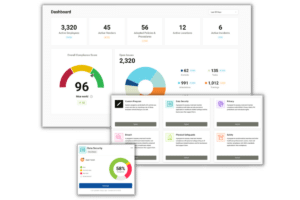
August 2025 delivered a stark reminder that healthcare organizations remain prime targets for cybercriminals. With 55 reported breaches affecting over 3.5 million patients, the month highlighted critical vulnerabilities that demand immediate attention.
The Staggering Reality: By the Numbers
August 2025 wasn’t just another month for healthcare cybersecurity—it was a crisis in real-time. The data tells a sobering story:
- 55 separate breach incidents reported to the Department of Health and Human Services
- 3,578,464 patients had their protected health information compromised
- Average breach size: Over 65,000 individuals per incident
- 87.3% of breaches were the result of hacking and IT incidents
But perhaps the most alarming statistic? Nearly 99.2% of affected patients had their data stolen from network servers—the very backbone of modern healthcare IT infrastructure.
The Elephant in the Room: DaVita’s Massive Breach
While 55 breaches occurred, one incident dwarfed all others. DaVita Inc.’s breach alone affected 2.69 million patients—representing 75% of August’s total victims. This kidney care giant’s network server compromise serves as a chilling reminder that when large healthcare organizations fall, the impact reverberates across millions of lives.
The DaVita incident underscores a critical truth: in healthcare cybersecurity, size matters. Large providers managing extensive patient databases become high-value targets, and when their defenses fail, the consequences are catastrophic.
Where Healthcare Organizations Are Most Vulnerable
Network Servers: The Primary Target
Our analysis reveals that 67.3% of breaches targeted network servers, accounting for 99.2% of compromised patient records. This concentration of risk in core IT infrastructure exposes a fundamental weakness in how healthcare organizations architect their cybersecurity defenses.
Email Systems: The Secondary Threat
Email-based attacks represented 23.6% of breaches, though they typically affected smaller patient populations. These incidents often stem from phishing attacks, compromised credentials, or insider threats.
The Human Factor
While electronic systems bore the brunt of attacks, unauthorized access and disclosure incidents—often involving human error or malicious insiders—still accounted for 12.7% of breaches.
The Business Associate Blind Spot
Healthcare organizations often focus security efforts on their own systems while overlooking a critical vulnerability: their business associates. Our data shows that 20% of August breaches involved business associates—third-party vendors with access to protected health information.
These BA breaches, while typically smaller in scale, represent a dangerous expansion of the healthcare attack surface. From IT service providers to billing companies, each business associate relationship introduces new cybersecurity risks that healthcare organizations must actively manage.
Five Critical Lessons from August’s Breaches
1. Size Amplifies Risk
Large healthcare providers face exponentially greater consequences when breached. The DaVita incident demonstrates that enterprise-scale organizations need enterprise-scale security measures.
2. Network Security Cannot Be an Afterthought
With 99.2% of affected patients compromised through network server attacks, robust network security isn’t optional—it’s essential. Healthcare organizations must treat their network infrastructure as their most critical asset.
3. Email Remains a Gateway for Attackers
Nearly a quarter of breaches originated through email systems, highlighting the persistent threat of phishing and email-based attacks in healthcare environments.
4. Business Associate Risk Is Organizational Risk
Third-party breaches affecting your patients become your responsibility. Healthcare organizations must extend their security oversight to every vendor with access to PHI.
5. Hacking Incidents Dominate the Threat Landscape
With 87.3% of breaches resulting from hacking incidents, healthcare organizations face sophisticated cybercriminal groups, not just opportunistic attacks.
Your Action Plan: 8 Steps to Strengthen Healthcare Cybersecurity
Immediate Actions (0-30 days)
- Conduct a Network Security Audit: Given that 99.2% of compromised patients were affected through network server breaches, prioritize a comprehensive assessment of your network infrastructure.
- Implement Email Security Controls: Deploy advanced email filtering, anti-phishing tools, and user training programs to address the 23.6% of breaches originating through email systems.
Short-term Initiatives (30-90 days)
- Strengthen Business Associate Agreements: Review and update all BA agreements to include specific cybersecurity requirements, regular security assessments, and incident response protocols.
- Deploy Network Segmentation: Isolate critical systems and limit lateral movement opportunities for attackers who breach your perimeter defenses.
- Enhance Access Controls: Implement zero-trust principles, multi-factor authentication, and privileged access management to prevent unauthorized access incidents.
Long-term Strategic Investments (90+ days)
- Invest in Advanced Threat Detection: Deploy AI-powered security tools that can identify and respond to sophisticated attacks before they result in massive data theft.
- Develop Incident Response Capabilities: Create and regularly test comprehensive incident response plans that can minimize damage when breaches occur.
- Establish Continuous Security Monitoring: Implement 24/7 security operations capabilities to detect and respond to threats in real-time.
The Cost of Inaction
August 2025’s breach data reveals an uncomfortable truth: healthcare cybersecurity isn’t keeping pace with evolving threats. With over 3.5 million patients affected in a single month, the human cost of inadequate cybersecurity extends far beyond financial penalties.
Each breached record represents a real person whose medical privacy has been violated, whose identity may be stolen, and whose trust in the healthcare system has been shaken. The regulatory fines, lawsuit settlements, and reputation damage are just the beginning of the true cost.
Moving Forward: A Call to Action
The healthcare industry stands at a cybersecurity crossroads. The August 2025 breach data provides a clear roadmap of where vulnerabilities exist and how attackers are exploiting them. The question isn’t whether your organization will be targeted—it’s whether you’ll be prepared when it happens.
Healthcare leaders must recognize that cybersecurity isn’t an IT problem—it’s a patient safety issue. Just as hospitals invest in medical equipment to save lives, they must invest in cybersecurity infrastructure to protect the digital lives of their patients.
The 55 breaches of August 2025 serve as both a warning and an opportunity. Organizations that act decisively to address these vulnerabilities will protect their patients and strengthen their operations. Those that don’t may find themselves in next month’s breach statistics.
The choice is clear: invest in cybersecurity today, or pay the much higher price of a breach tomorrow.









